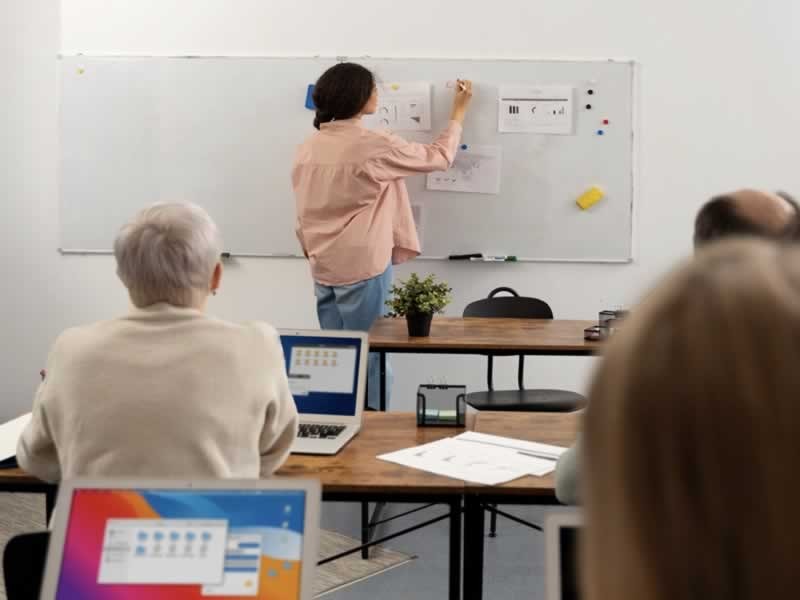Insight Blog
Agility’s perspectives on transforming the employee's experience throughout remote transformation using connected enterprise tools.
12 minutes reading time
(2358 words)
Edge Method of Teaching | UPDATED 2024 | A Comprehensive Guide
Explore the transformative Edge Method of Teaching for dynamic, effective, and engaging educational experiences.
This is the updated 2024 comprehensive guide on the "Edge Method of Teaching." In a dynamic educational landscape, innovative approaches to teaching and presentation are essential for engaging and effective learning experiences. The Edge Method, with its unique principles and adaptable strategies, stands as a promising solution.
This article aims to provide a detailed exploration of the Edge Method, covering its origins, key principles, and practical implementation. We'll go into its evolution and how organizations like the Boy Scouts of America (BSA) have embraced it. Whether you're an educator looking to enhance your teaching methods or a presenter aiming to captivate your audience, this guide offers insights, real-world examples, and best practices to help you leverage the Edge Method successfully.
Let's embark on this educational journey to discover the power of the Edge Method in teaching and presentations.
What Is The Edge Method? A Complete Guide
So, what is the edge method?
The Edge Method is a dynamic teaching and presentation approach designed to enhance engagement and effectiveness.
It embodies a set of principles and techniques that empower educators and presenters to deliver impactful learning experiences. Explore the core principles and applications of this innovative method here.
- E: Explaining the task
- D: Demonstrating the steps of the task
- G: Guiding the scout through the steps of the task
- E: Enabling the scout to do the task on their own
We will go into more detial about the Core Components of edge.
Understanding the Edge Methodology
The Edge Methodology represents a paradigm shift in education and communication. Rooted in the belief that traditional approaches often fall short in engaging audiences, this innovative method prioritizes dynamic, impactful, and effective interactions. At its core, the Edge Methodology revolves around storytelling, recognizing the power of narrative to captivate and convey complex ideas. It also leverages visual aids, embracing technology's potential to enhance understanding. Interactivity is a fundamental tenet, encouraging audience participation and fostering a sense of co-creation.
This methodology offers a dynamic framework for educators, presenters, and communicators to transcend traditional boundaries, creating memorable, influential, and genuinely immersive experiences.
History and Evolution
The history and evolution of the Edge Method provide valuable insights into its transformative impact. Initially emerging as a response to the limitations of conventional teaching and communication, the methodology has undergone a remarkable evolution. It draws inspiration from diverse fields, including psychology, technology, and storytelling, to craft a dynamic approach that transcends traditional boundaries. This journey from its inception to its current state reflects the adaptability and innovative spirit that characterize the Edge Method.
Follow us and access great exclusive content everyday: Follow us on Google News
Key Principles
Central to the Edge Method is a set of key principles that underpin its effectiveness. These principles include a focus on storytelling as a powerful communication tool, leveraging visual aids to enhance understanding, and promoting interactivity to engage audiences actively. Additionally, the method emphasizes clarity, adaptability, and tailored content to suit the audience's needs. These core principles form the foundation of the Edge Method, guiding educators, presenters, and communicators in their quest to create impactful, engaging, and transformative experiences for their audiences.
The Edge Method By The Boy Scouts of America (BSA)
Originating from the Boy Scouts of America (BSA), this method has evolved over time, adapting to the changing landscape of education and communication. Its key principles, including adaptability, engagement, and learner-centeredness, serve as the foundation for its successful application. Whether you're an educator looking to revamp your teaching methods or a presenter aiming to captivate your audience, the Edge Method offers a powerful toolkit for achieving your goals.
You may also like: Best Apps for Employees: UPDATED 2022 – A Complete Guide
Origin and Development
The Boy Scouts of America (BSA) played a crucial role in the Edge Method's birth and evolution. It emerged from years of practical scouting experience, recognizing the need for efficient skill transfer between Scouts. BSA leaders formalized the four-step process of Explain, Demonstrate, Guide, and Enable (EDGE) in the 1970s, incorporating it into training materials and manuals.
The organization actively promotes its use within Scouting activities, encouraging older Scouts to teach younger ones using the Edge Method.
This not only builds valuable leadership skills but also ensures the legacy of essential outdoor and practical knowledge across generations. Moreover, BSA continues to refine and update the Edge Method based on research and feedback, ensuring its continued relevance and effectiveness in fostering well-rounded, skilled young individuals.
Core Components
The Edge Method's power lies in its simplicity and structure. BSA's version distills it into four core elements:
- Explain: Experienced Scouts or adult leaders clearly and concisely break down the skill or concept, highlighting key steps and their importance.
- Demonstrate: Following explanation comes visual learning. The instructor slowly, and meticulously performs the skill, emphasizing each stage and proper technique.
- Guide: Questions and clarifications are freely encouraged as the instructor acts as a guide, ensuring understanding before practice.
- Enable: Finally, Scouts take the reins, practicing the skill under watchful eyes.
Individual feedback and adjustments refine their technique, guiding them toward mastery. These four pillars, seamlessly interwoven, empower Scouts to learn from peers, fostering both skill development and leadership potential.
Free ebook: How To Get Your Intranet Off The Ground
Success Stories
The Edge Method's impact within BSA extends far beyond theoretical frameworks. Consider a troop struggling to master campfire building. Senior Scouts, armed with the Edge Method, meticulously explain and demonstrate fire-starting techniques, guiding younger Scouts through practice with individual feedback. Soon, the crackling flames become a testament to their collective learning journey.
Similarly, during a wilderness survival exercise, experienced Scouts utilize the Edge Method to teach compass navigation, transforming apprehensive novices into confident pathfinders.
These are just glimpses into the transformative power of the Edge Method, empowering Scouts to not only acquire valuable skills but also develop leadership potential and build lasting bonds of camaraderie.
Implementing The Edge Method of Teaching
Implementing the Edge Method of Teaching is a pivotal step towards revolutionizing the educational experience. This dynamic approach offers educators the tools and strategies needed to engage learners effectively and create meaningful learning experiences. Whether you're a teacher, trainer, or instructional designer, understanding how to implement the Edge Method can make a significant impact on your teaching and the outcomes of your learners.
Preparing for Implementation
Laying the groundwork for a successful Edge Method implementation is crucial. Just like a seasoned Scout preparing for a wilderness trek, meticulous planning ensures a smooth and rewarding learning journey.
Here are some key steps to take before putting the EDGE into action:
- What specific skill or concept will you be teaching? Tailor the objectives to the age, experience, and interests of your learners. Be SMART: Specific, Measurable, Achievable, Relevant, and Time-bound.
- Collect all necessary materials and equipment. Ensure they are age-appropriate, readily available, and in good working condition. Consider visual aids like diagrams, charts, or props to enhance understanding.
- Map out the four stages of the Edge Method: Explain, Demonstrate, Guide, and Enable. Allocate sufficient time for each step, allowing for practice and individual attention. Incorporate interactive elements, games, or role-playing to keep learners engaged.
- Create a safe and encouraging space where learners feel comfortable asking questions and making mistakes. Promote teamwork and collaboration among learners. Celebrate successes and acknowledge the effort put into learning.
- Try out the lesson plan with a small group before implementing it with a larger audience. Gather feedback from learners and instructors to identify areas for improvement. Be flexible and adapt the method to fit the specific needs of your learners.
By following these steps and approaching the Edge Method with a spirit of preparation and adaptability, you can set the stage for a transformative learning experience for your Scouts. Remember, the Edge Method is a powerful tool, but its effectiveness ultimately hinges on the care and thoughtfulness invested in its implementation.
Moreover, try to leverage technology! Utilize educational apps, online tutorials, or even video demonstrations to supplement your in-person teaching. Remember, the more engaging and interactive the learning experience, the more likely it is to leave a lasting impact on your Scouts.
Practical Application
Applying the Edge Method in teaching scenarios involves a systematic approach designed to maximize its effectiveness. For educators interested in personalized learning support, there are valuable examples of how to support students as an Ignite Fellow through high-impact tutoring roles that empower students with individualized guidance and mentorship. Begin by providing a clear explanation of the skill or concept, followed by a proficient demonstration. As you transition into guiding learners and enabling independent practice, encourage questions and foster self-directed learning.
Regularly assess progress, adapt to individual needs, and promote real-life application of knowledge. Maintain open communication with learners, using their feedback to refine your teaching approach. This structured method empowers educators to create engaging and participatory learning experiences, ensuring that learners actively contribute to their own educational journey.
Overcoming Challenges
Implementing The Edge Method of Teaching requires astute navigation through several typical hindrances. Firstly, resource scarcity often impedes progress; creative allocation and utilization of available assets are paramount. Secondly, resistance from educators, rooted in unfamiliarity with this innovative approach, necessitates comprehensive training and gradual integration.
Thirdly, student adaptability varies; personalized strategies enhance engagement. Lastly, consistent evaluation and feedback mechanisms are essential for refining methodologies and ensuring efficacy. These challenges, while formidable, offer opportunities for growth and improvement in the educational landscape.
Edge Method Presentations: How Can You Use it?
Edge Method presentations can revolutionize your meetings, infusing them with dynamic engagement and effective communication. This approach, distinct in its ability to captivate and educate audiences, leverages cutting-edge techniques and tools. It emphasizes clarity, interactivity, and a keen understanding of audience needs.
Adopting The Edge Method transforms mundane presentations into memorable, impactful experiences. Here, we will highlight its core principles, offering a roadmap for anyone seeking to elevate their presentation skills.
Adapting the Edge Method for Presentations
Incorporating The Edge Method into presentations demands a blend of innovative techniques and traditional principles. Key among these is the use of storytelling, a powerful tool that fosters a strong connection with the audience. By weaving narratives that resonate, presenters can enhance retention and understanding. Visual aids play a crucial role, too; incorporating engaging graphics and animations aids in simplifying complex concepts, making them more accessible.
Interactivity is another cornerstone of The Edge Method. Encouraging audience participation through questions, polls, or interactive segments keeps the audience engaged and fosters a two-way communication stream. Tailoring the content to the audience's background and interests is vital; this ensures relevancy and maximizes impact.
Furthermore, The Edge Method advocates for a clear structure in presentations. Beginning with a compelling introduction, followed by a well-organized body and a memorable conclusion, creates a coherent and persuasive narrative. Emphasizing key points through repetition and highlighting aids in reinforcing the message.
Lastly, practicing adaptability is crucial. Being prepared to modify the presentation in real time based on audience feedback or engagement levels is a skill that can greatly enhance the effectiveness of the method.
Real-World Examples
Successful implementations of The Edge Method in presentations abound across various sectors. A notable example is in the field of education, where a university professor transformed a complex scientific lecture into an engaging narrative. By incorporating storytelling, the professor made difficult concepts approachable, leading to increased student comprehension and participation.
In the corporate world, a marketing team employed The Edge Method to pitch a new product. They used interactive elements like live demos and audience Q&A sessions, which not only captivated the audience but also provided real-time feedback, crucial for tailoring their message.
Another instance was at a tech conference, where a keynote speaker utilized visually striking slides and a clear, structured narrative to explain emerging technologies. This approach facilitated understanding among a diverse audience, ranging from experts to novices.
Tips and Best Practices
For optimizing Edge Method presentations, several practical tips can significantly enhance their impact. First, deeply understand your audience; tailor your content to match their interests and background, making it relevant and engaging. Employ storytelling techniques to simplify complex topics and make them relatable. Use visual aids judiciously to clarify points and maintain interest.
Encourage audience interactivity; incorporate questions, polls, and discussions to foster a two-way communication channel. Practice flexibility; be prepared to adjust your presentation based on real-time audience feedback. Lastly, ensure a clear structure with a compelling introduction, a coherent body, and a memorable conclusion.
These strategies collectively ensure your presentation is not only informative but also captivating and impactful.
Wrapping
The Edge Method presents a revolutionary perspective on delivering presentations, seamlessly weaving together the art of storytelling, captivating visual elements, and meaningful audience interaction. By customizing the content to suit the specific needs and interests of the audience, leveraging cutting-edge visual aids, and cultivating an interactive dialogue, presenters have the power to elevate the effectiveness of their presentations to new heights.
This method transcends the conventional one-way communication model, encouraging a dynamic exchange of ideas. The incorporation of innovative visual elements not only captures attention but also serves as a powerful tool for reinforcing key points. Moreover, by fostering a two-way communication stream, presenters can establish a deeper connection with their audience, ensuring that the information not only reaches its intended destination but resonates profoundly.
The Edge Method goes beyond mere information dissemination; it creates an immersive experience that leaves a lasting imprint on the audience's minds. By engaging both the intellect and emotions, this approach ensures that the message not only makes an impact in the moment but also fosters a sustained understanding and connection. Embracing The Edge Method transforms presentations into memorable, transformative experiences that go beyond traditional communication boundaries.
Categories
Blog
(2600)
Business Management
(319)
Employee Engagement
(207)
Digital Transformation
(173)
Intranets
(119)
Growth
(118)
Remote Work
(61)
Sales
(48)
Collaboration
(37)
Culture
(29)
Project management
(29)
Customer Experience
(26)
Knowledge Management
(21)
Leadership
(20)
Comparisons
(5)
Ready to learn more? 👍
One platform to optimize, manage and track all of your teams. Your new digital workplace is a click away. 🚀
Free for 14 days, no credit card required.
















